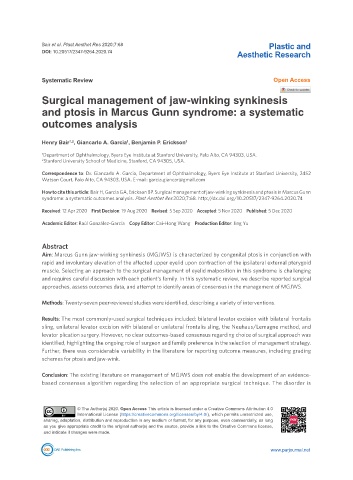Page 797 - Read Online
P. 797
Bair et al. Plast Aesthet Res 2020;7:68 Plastic and
DOI: 10.20517/2347-9264.2020.74 Aesthetic Research
Systematic Review Open Access
Surgical management of jaw-winking synkinesis
and ptosis in Marcus Gunn syndrome: a systematic
outcomes analysis
Henry Bair , Giancarlo A. Garcia , Benjamin P. Erickson 1
1
1,2
1 Department of Ophthalmology, Byers Eye Institute at Stanford University, Palo Alto, CA 94303, USA.
2 Stanford University School of Medicine, Stanford, CA 94305, USA.
Correspondence to: Dr. Giancarlo A. Garcia, Department of Ophthalmology, Byers Eye Institute at Stanford University, 2452
Watson Court, Palo Alto, CA 94303, USA. E-mail: garcia.giancar@gmail.com
How to cite this article: Bair H, Garcia GA, Erickson BP. Surgical management of jaw-winking synkinesis and ptosis in Marcus Gunn
syndrome: a systematic outcomes analysis. Plast Aesthet Res 2020;7:68. http://dx.doi.org/10.20517/2347-9264.2020.74
Received: 12 Apr 2020 First Decision: 19 Aug 2020 Revised: 5 Sep 2020 Accepted: 5 Nov 2020 Published: 5 Dec 2020
Academic Editor: Raúl González-García Copy Editor: Cai-Hong Wang Production Editor: Jing Yu
Abstract
Aim: Marcus Gunn jaw-winking synkinesis (MGJWS) is characterized by congenital ptosis in conjunction with
rapid and involuntary elevation of the affected upper eyelid upon contraction of the ipsilateral external pterygoid
muscle. Selecting an approach to the surgical management of eyelid malposition in this syndrome is challenging
and requires careful discussion with each patient’s family. In this systematic review, we describe reported surgical
approaches, assess outcomes data, and attempt to identify areas of consensus in the management of MGJWS.
Methods: Twenty-seven peer-reviewed studies were identified, describing a variety of interventions.
Results: The most commonly-used surgical techniques included: bilateral levator excision with bilateral frontalis
sling, unilateral levator excision with bilateral or unilateral frontalis sling, the Neuhaus/Lemagne method, and
levator plication surgery. However, no clear outcomes-based consensus regarding choice of surgical approach was
identified, highlighting the ongoing role of surgeon and family preference in the selection of management strategy.
Further, there was considerable variability in the literature for reporting outcome measures, including grading
schemes for ptosis and jaw-wink.
Conclusion: The existing literature on management of MGJWS does not enable the development of an evidence-
based consensus algorithm regarding the selection of an appropriate surgical technique. The disorder is
© The Author(s) 2020. Open Access This article is licensed under a Creative Commons Attribution 4.0
International License (https://creativecommons.org/licenses/by/4.0/), which permits unrestricted use,
sharing, adaptation, distribution and reproduction in any medium or format, for any purpose, even commercially, as long
as you give appropriate credit to the original author(s) and the source, provide a link to the Creative Commons license,
and indicate if changes were made.
www.parjournal.net

